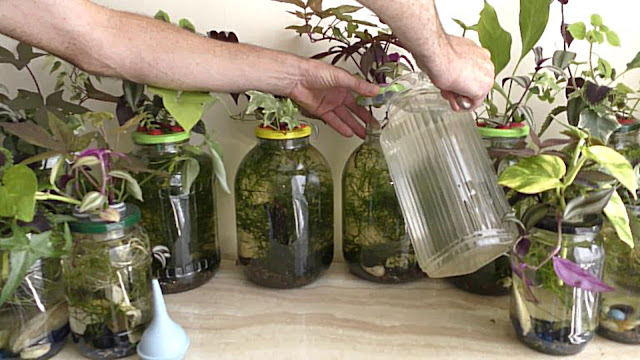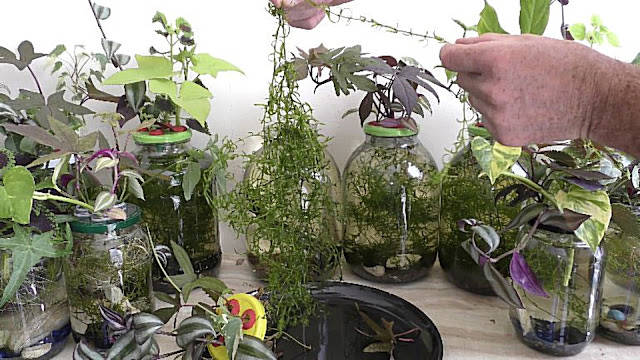In my recent Aquarium Fish Care live stream, I explained the basic weekly care I provide for my sustainable aquariums with fish through the past year 2020.
There are some more details I want to share with you.
I use only one source of light - natural indirect sunlight coming from a window for all my aquariums with fish.
The temperature in my apartment is about 72-76 F (22-25 C) all year around.
Which is a perfectly normal temperature for any tropical fish.
Low temperature fluctuations through the year is important factor for keeping and breeding tropical fish.
Also remember that warmer water has less oxygen in it.
Fish may suffocate in water warmer than 85F (30C).
So be mindful about it, especially during hot Summer.
Okay, let's move my 1 liter sustainable aquariums without fish out of the way to get a better view at 3 liter sustainable aquariums with guppies - the main subject of this video.
I add New York City dechlorinated tap water to the level in all aquariums once a week.
Every Monday morning to be precise.
Lift up the planter and just pour the water in up to the level.
Actually I prefer injecting water through the holes in the planter.
Water evaporates from my aquariums mostly through the leaves of the plants.
The larger the plant, the more water evaporates.
Checking on and adding water weekly is a good weekly routine.
Even though, aquarium gardens can be left for weeks and months without adding water.
The same is true about feeding my guppies.
I feed guppies with homemade fish food once a week.
I give them just a pinch of food.
It is supplemental feeding in addition to what guppies find in aquariums at any time.
I made this food from plants and critters growing in the same aquariums.
So, the feeding is really supplemental :)
Supplemental feeding is optional in well planted sustainable aquariums populated with tiny aquatic critters.
My dwarf guppies can go without feeding for up to one month - I checked it and will publish a video about it ;)
Supplemental feeding certainly helps to encourage breeding and keeps fish healthy.
So, I feed my dwarves once a week.
Taking care of plants is another part of the weekly routine.
Algae and plants feed on nutrition (organic waste of animals and dead plants) dissolved in water.
Plants growing on top of aquariums feed on nutrition that algae may feed on otherwise.
Fast growing land plants are more efficient than aquatic plants in this regards ;)
I remove and trim old wilting leaves, add new plants, or replace old plants as necessary.
Healthy leaves of many land plants that I grow on top of aquariums can be used for making fish food.
Removing old wilting parts of aquatic plants is a necessary step for preventing algae bloom.
I do it as necessary...once a month or so.
The old wilting parts are usually on the bottom.
So, I have to pull out the whole plant first.
In this example, it is Guppy grass.
Guppy grass is one of the fastest growing plants that I keep in my aquariums.
There are also some slow growing plants.
I like to keep at least two types of plants in each aquarium.
Remove the wilting, brownish, dying parts of the plants.
The healthy fresh green parts can go back into the aquarium.
Aha, here is a nice example to show...
The wilting part is darker, and the young part is brighter.
I remove the old wilting and put the young part back into the aquarium.
There also snails, scuds and (I am sure there are) seed shrimp on the plants.
I let them stay on whatever part of the plant they happen to be.
If critters happen to be on the young part of the plant then they go back into the aquarium to live and breed.
Otherwise, they go back into the aquarium in the form of...fish food.
Actually, those critters are fish food either way.
The only difference is whether the fish eat them alive or get them as fish food flakes.
Now let's fix plants in the the next aquarium.
Trimming aquatic plants is not a part of my weekly routine to be sure.
Monitoring plants is a weekly routine.
Trimming is done as necessary...once a month or two.
More often in Summer when plants grow faster.
Monitoring has to be done weekly or...let's say as often as it can be done to ensure aquarium health.
Here is a cutting of hornwort - another fast growing plant.
Weekly monitoring helps to notice changes, such as wilting plants or plants going dormant, that may lead to algae bloom.
It is simpler to prevent than to treat algae outbreaks.
Ah, here are some snails...I put them back.
And here is an adult scud...
I have it already in my hands, so let's put it back in aquarium.
I add spare cuttings to other aquariums where they are needed.
This 1 liter aquarium garden certainly needs some aquatic plants.
So, let's pick a couple fresh green cuttings and put them in.
Fast growing plants double in the size about every month through the Summer - so I get a lot of cuttings.
I leave the old and fresh unused cuttings to dry on a plate as it is with whatever critters on them.
Here you can see guppies having fun exploring new places in the old aquarium :)
Guppies are very curious about everything new.
You may notice different sized snails I have adopted from ponds.
They breed very well.
Put the plate with plants on the shelf between aquariums.
It would take a couple days at this room temperature for plants and critters to dry.
Look at these beautiful blooms.
Yes, that is the thing about aquarium gardens - they are gardens :)
Also not a part of my weekly routine, nevertheless an important part of aquarium garden care is to add new plants.
In this example, I add growing underwater land moss.
Mosses grow in a nice mesh where critters love to hide from fish.
My scuds devour moss!
And guppies nibble moss all the time too.
In a couple days, the trimmed aquatic plants dried out.
I crush the dry plants in my palms making a pile of flakes and dry stems.
There is so much food for my fish that I don't see the point of using stems for fish food.
Move stems in a separate pile.
Mix the flakes with an old batch of fish food flakes.
The fresh mixed of dried food grown in the aquariums goes back into the same aquariums, completing the cycle of sustainability :)
Checking on land plants growing with roots in water is an important part of my weekly routine.
Some plants need more attention than others.
But the basic care is to remove wilted leaves, trim roots, and make new cuttings as necessary.
Also, I cut off large healthy leaves of some plants to use them for making fish food.
In this example, I cut off leaves of ornamental sweet potato.
I remove stems from the leaves right away.
Dry them the same way as shown previously.
Aquatic plants dry faster than land plants.
I actually have videos showing how to prepare homemade fish food.
Check links in the description or just look through playlists of my videos ;)
So, that is the essence of sustainable aquarium fish care: no water changes, no air pumps, no man-made filters.
Just add water as needed, trim plants, and feed fish with what grows in the aquariums.
Patients and observation are necessary for successful aquarium keeping.
Have fun and happy aquarium gardens :)



































































No comments:
Post a Comment